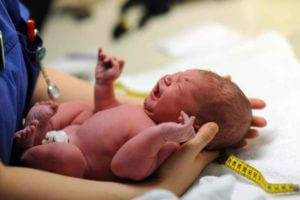Your birth is getting closer and closer and your thoughts are all around the topic: Can I prevent the perineal tear? Whether this is really possible and what you can do, you can read in the following article.
Table of contents
What Is A Perineal Tear?
A perineal tear is actually one of the most common injuries that can occur during childbirth. The perineum, the area between the vagina and the anus, can tear if stretched too much. Admittedly, not a pretty thought.
As I’m sure you know, the skin and muscles in this area are especially stressed during childbirth. A large child or a rapid birth can cause the skin to no longer withstand the enormous stretching and tear.
Especially when the child’s head passes through the birth canal, the stretching is particularly strong. In addition to the perineum, other areas can also tear or be damaged during childbirth. For example, the vaginal skin, labia, cervix or clitoris.
What Can Cause A Perineal Tear?
Unfortunately, it is impossible to predict whether or not a perineal tear will occur. A very large child, an unfavorable position of the child, a fast birth as well as an insufficient perineal protection can lead to this complication.
This is because perineal rupture is often the result of surgical vaginal birth. The use of mechanical aids such as forceps or vacuum deliveries is responsible for this.
There are also other factors that can promote perineal tears:
– The size and posture of the head, as well as the width of your newborn’s shoulders.
– Old scar tissue on the perineum (injuries from a previous birth).
– The condition of the perineal tissue: a particularly tight, unyielding tissue as well as a weak tissue (e.g. due to a weakness of the connective tissue) tear more quickly.
– An episiotomy
– So-called “power pressing
– Birth by suction cup or forceps
– Birth in the supine position: This is because the pressure of the head is thus shifted especially to the posterior pelvic floor and the anal sphincter.
Perineal Tear – What Now?
Immediately after the birth you will be examined by a gynecologist. Especially in the area of the vagina and the perineum. If there is indeed a perineal tear, he will assess the location and extent of the injury, as there are some differences.
- Also interesting:
- The best swing frames
- Recommended 366 trampolines
- Recommendable children’s workbenches
First of all, he will ask the following questions:
– What is the location of the tear?
– Is only the skin torn?
– Is the perineal musculature also injured?
– Is the sphincter muscle involved?
– To what extent is the bowel involved in the perineal tear?
Extent Of The Injury
As you already know, a perineal tear can have very different consequences. Sometimes it is just bleeding, but sometimes it is far more drastic. Above all, the exact location as well as the extent of the injury are crucial here.
Perineal Tear Of The 1st Degree
The skin on the perineum is only torn superficially. The muscles themselves are not affected.
Perineal Tear Of The 2nd Degree
The injury affects not only the skin but also the muscles. The sphincter muscle is not affected.
Perineal Tear 3rd Degree
The sphincter muscle has been damaged. It is partially or completely torn.
Perineal Tear 4th Degree
Sphincter muscle is completely torn. In addition, the intestinal mucosa is affected.
What Is An Episiotomy?
An episiotomy, also called an episiotomy, is sometimes purposefully placed by a doctor. In this case, the doctor enlarges the pelvic outlet by making an episiotomy.
However, the action of an episiotomy does not guarantee an episiotomy. This is because if this incision is not large enough, the tissue can still tear.
Does An Episiotomy Cause Pain?
Unfortunately, you can’t answer that with either “yes” or “no”. Of course, it is not painless when tissue tears. However, during childbirth you will be confronted with quite different pain. You will probably not notice a perineal tear.
An episiotomy is basically noticeable by pain and bleeding.
Can I Prevent An Episiotomy?
A perineal tear can have many causes, as you already know. If you are now asking yourself: Can I prevent an episiotomy? Here are some tips for you:
Massage
Your gynecologist may have recommended a so-called perineal massage. Using a special oil and certain massage techniques, you can stretch the area and prepare it for birth. You should start regular massages about eight weeks before the birth.
Gymnastics
Perineal gymnastics also provides a stretching effect. Squat down with your knees open or sit cross-legged. In this position you must now press your feet against each other. About six weeks before the birth you should start with the daily exercises, at best several times a day.
Exercise Equipment
A so-called “anti-perineal trainer” has exactly the same effect. This is a balloon that is inserted into the vagina and inflated more and more over time. This method is intended to stretch the perineal tissue. You should discuss whether this device is suitable for you with your doctor or midwife beforehand.
Strong Pelvic Floor
Regular pelvic floor training can help you to consciously tense your muscles during labor.
Through specific exercises, you can learn how to control your pelvic floor properly.
In this way, at best, you can manage not to cramp up during birth. The perineal tissue is also relieved and does not tear as quickly.
Herbal Helpers To Prevent Perineal Tear
In addition to exercises, here are tips on how to prevent perineal tear, with the help of external applications.
Sitz Bath
A sitz bath loosens the tissues and makes them supple at the same time. For the sitz bath, it is best to pour boiling water on hay or linden flowers and then sit in the slightly cooled water for some time.
You can start with the sitz baths about six weeks before the birth: Once a week, and daily from the date of delivery.
Raspberry Leaf Tea
Raspberry leaf tea has the effect of making the perineal area as well as the pelvic floor more elastic. In addition, the tea is also said to relax the abdominal muscles. How often you can drink the tea, you should discuss with your doctor. Raspberry leaf tea has a labor-promoting effect.
Nutrition
You certainly know how important a healthy and balanced diet is. Moreover, proper nutrition can contribute to healthy and resistant skin tissues. Foods like fruits, vegetables, nuts, seeds or carbohydrates from amaranth or quinoa are good for you and your body!
The Best Preparation Cannot Prevent A Perineal Tear
Although you have learned some tips and tricks so far on how to prevent perineal tear, unfortunately, these alone do not offer any guarantee.
A perineal tear can occur even despite the best preparation.
Neither you nor your doctor can influence all the processes of your body.
But: it is possible that the injuries would have been much worse without preparation, and you might have been able to minimize at least the extent of the perineal tear.
Sources:
https://www.netdoktor.de/krankheiten/dammriss/
https://www.babyartikel.de/magazin/dammriss-vorbeugen-vermeiden












